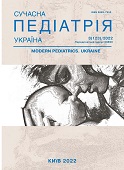The condition of periodontal tissues in teenagers and young adults who smoke
DOI:
https://doi.org/10.15574/SP.2022.123.33Keywords:
teenagers, young adults, prevalence of periodontal diseases, OHI-S hygiene index, PMA, PBI, smokingAbstract
The effect of smoking on the human body is multifactorial, due to chemical carcinogens, ionizing radiation, thermal, toxic, irritating and general resorption action. Thus, the question of studying the effect of smoking on the condition of periodontal tissues in teenagers and young adults is relevant.
Purpose - to study the effect of harmful smoking habits on the condition of periodontal tissues in teenagers and young adults.
Materials and methods. The dental status of 114 adolescents and young people (from 15 to 24 years old) was studied, which were divided into groups: group I involved 26 people who regularly smoke traditional cigarettes; to the second group - 22 people who regularly smoke electronic cigarettes (Vapi); to group III - 23 people who regularly smoke tobacco heaters (IQOS); to group IV - 43 people without a bad habit of smoking. The prevalence of periodontal diseases, OHI-S index, PMA index, PBI index was established.
Results. It was found that the prevalence of periodontal disease averaged 72.36%. In the subjects of group I - the OHI-S index was equal to 1.77±0.02 points, in the subjects of group II - 1.53±0.01 points, in the subjects of group III - 1.46±0.02 points, in the subjects of group IV groups - 0.87±0.03 points. In persons of group I the value of the PMA index was 38.6±3.26%, in persons of group II - 33.7±2.52%, in persons of group III - 31.6±1.84%, in persons of group IV - 22.8±2.73%. The bleeding index of PBI in persons of group I was 1.18±0.02 points, in persons of group II - 1.43±0.03 points, in persons of group III - 1.39±0.02 points, in persons of group IV - 1.27±0.01 points.
Conclusions. The study found a negative effect of bad smoking habits on the condition of periodontal tissues in teenagers and young adults.
The research was carried out in accordance with the principles of the Helsinki Declaration. The study protocol was approved by the Local ethics committee of the participating institution. The informed consent of the patient was obtained for conducting the studies.
No conflict of interests was declared by the author.
References
Chaplyak AP, Romanov OP, Nagy BYa. (2018). Problems of tobacco prevention among adolescents. Economics and health law. 2 (8): 142-143.
Chumakova YuG, Kosenko KN, Vishnevskaya AA. (2012). Smoking - as a risk factor for periodontal disease (literature review). Bulletin of dentistry. 6 (79): 86-95.
Decik OZ. (2011). Methodical approaches to generalization of scientific research results. Galician Medical Bulletin. 18 (2): 5-8.
Forthofer RN, Lee ES, Hernandez M. (2007). Biostatistics: A Guide to Design, Biostatistics. Analysis and Discovery. Amsterdam, etc.: Elsevier Academic Press: 502.
Giano R. (2015). Diagnosis and treatment of periodontal disease: a book. M .: Azbuka: 739.
Herbert WF. (2014). Periodontology. M: Publishing House «Medpress-Inform»: 548.
Homenko LO, Bidenko NV, Ostapko OL, Golubeva IM. (2016). Pediatric periodontology: the state of problems in the world and in Ukraine. Dentistry news. 3 (88): 67-71.
Homenko LO. (2015). Therapeutic dentistry for children. 2: 328.
Ilchyshyn MP, Furdychko AI, Barilyak AY, Fedun IR, Gan IV. (2020). Features of the influence of tobacco heating systems (GLO and IQOS) on the condition of oral tissues. Ukrainian Journal of Medicine, Biology and Sports. 5, 6 (28): 247-251. https://doi.org/10.26693/jmbs05.06.247
Korolyova ND, Chorna VV, Humeniuk NI, Angelska VYU, Khlestova SS. (2019). Prevalence of smoking among medical students. Environment and Health. 3: 28-30.
Krivenko LS, Tishchenko OV, Lepilina KM. (2020). Influence of alternative smoking methods on the features of objective and subjective indicators of oral health. Problems of continuing medical education and science. 2 (38): 20-23. https://doi.org/10.31071/promedosvity2020.02.020
Lamont RJ, Hajishengallis GN, Jenkinson HF. (2014). Oral microbiology and immunology. United Kingdom: 531. https://doi.org/10.1128/9781555818906
Maliy DU, Antonenko MJ. (2013). Epidemiology of periodontal disease: age aspect. Ukrainian Scientific-Medical Youth Journal. 3: 41-43.
Mayo Clinic. (2014). Periodontal disease. More than just gums. 32 (10): ZE01-4.
Miech R, Johnston L, O'Malley PM, Bachman JG. (2019). Trends in Adolescent Vaping. N Engl J Med. 381: 1490-1491. https://doi.org/10.1056/NEJMc1910739; PMid:31532955 PMCid:PMC7310772
Picas OB. (2015). Cigarette smoking among the population and its role in the development of diseases. Bulletin of problems of biology and medicine. 1 (126): 48-52.
Savichuk NO. (2021). Oral microbiome and its role in maintaining general and dental health. Medical newspaper «Health of Ukraine of the 21st century». 25 (4): 497. URL: http://health-ua.com/article/64438-mkrobom-porozhnini-rota--tajogo-rol-updtrimann-zagalnogo-jstomatologchnogo-.
Shcherba VV, Lavrin OY. (2016). Smoking: prevalence and effects on organs and tissues of the oral cavity (literature review). Clinical dentistry. 2: 27-33.
Sidelnikova LF, Revenok BA. Myalkivskiy KO. (2016). Hygienic and psychological aspects of improving the effectiveness of treatment of inflammatory periodontal diseases in young people. Preventive and pediatric dentistry. Profilaktichna ta dituacha stomatologia. 2 (15): 5-9.
Vankhanova TO. (2019). Passive smoking during pregnancy and its consequences for the newborn. The current state of the problem (literature review). Modern pediatrics. Ukraine. 4 (100): 53-59. https://doi.org/10.15574/SP.2019.100.53
WHO. (2021). Prevalence of tobacco smoking. Global Health Observatory (GHO) data. URL: https://www.who.int/gho/tobacco/use/en/.
Downloads
Published
Issue
Section
License
Copyright (c) 2022 Modern pediatrics. Ukraine

This work is licensed under a Creative Commons Attribution-NonCommercial 4.0 International License.
The policy of the Journal “MODERN PEDIATRICS. UKRAINE” is compatible with the vast majority of funders' of open access and self-archiving policies. The journal provides immediate open access route being convinced that everyone – not only scientists - can benefit from research results, and publishes articles exclusively under open access distribution, with a Creative Commons Attribution-Noncommercial 4.0 international license (СС BY-NC).
Authors transfer the copyright to the Journal “MODERN PEDIATRICS. UKRAINE” when the manuscript is accepted for publication. Authors declare that this manuscript has not been published nor is under simultaneous consideration for publication elsewhere. After publication, the articles become freely available on-line to the public.
Readers have the right to use, distribute, and reproduce articles in any medium, provided the articles and the journal are properly cited.
The use of published materials for commercial purposes is strongly prohibited.

